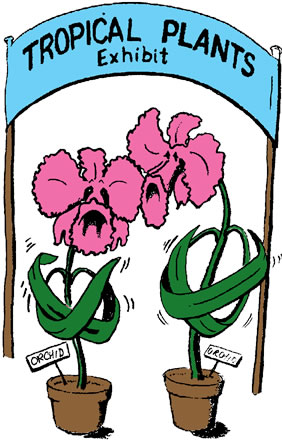EF6.2. Heat Trappers, Inc

{ Energy Flow Contents } { All GSS Books }

Your job as a member of Heat Trappers, Inc., is to work with a team of engineers (your fellow students) to create as warm an environment as possible for some miniature exotic tropical plants that have just been acquired for your school’s new botanical garden.
Your team will modify a shoe box to make a greenhouse. You can add features such as a window and insulation. Since a single layer of transparent material can both let heat in and (because it is a poor insulator) let heat out, a good question to think about is, “What will be the optimum size and construction of the window?”
Your team’s shoe box should have a thermometer showing the temperature of the air inside. You will then place your “greenhouse” in the Sun next to a closed shoe box that has not been modified, except with a thermometer to show temperature in the same way as in the “greenhouse” shoe box. Record the temperatures of the two boxes for about 20 minutes. You’ll find out whether or not Heat Trappers, Inc., succeeded in creating a warm greenhouse design.
Materials
- 2 shoe boxes of same color and thickness
- 2 thermometers (Celsius)
- 1 roll of tape
- 1 scissors and/or utility knife
- 1 clear plastic transparency
- 1 sheet of plastic sandwich wrap
- 1 copy of the data sheet and a pencil
- Odds and ends (dirt, rocks, colored paper, cardboard, foam insulation, etc.)
Investigation Strategies
- Design and construct your greenhouse heat trap.
a. Tape the thermometers inside the boxes so they measure the temperature of the inside air and can be read without opening the boxes. Shade the bulbs of the thermometers with a piece of paper or cardboard, so they are not heated by direct sunlight.
b. Stop air leaks in the boxes with tape. - Predict how the temperature of your greenhouse and the control box will change when they are placed in the sunlight. Select the graph below that you think shows how the temperature inside your greenhouse will change. How will it be different from the control box?
- Conduct a Greenhouse Test.
a. Record the temperature of your heat trap and control box indoors.
b. Place the boxes in sunlight. Make sure they are not disturbed, and that no shadows fall on them during the experiment.
c. On a data sheet like the one here, record and graph both temperatures every minute for about 24 minutes.
d. Bring the trap and control box back inside. Feel the outside of the containers. Are they warm?
Draw Conclusions
- Look closely at the graph, and compare it with your prediction. How would you describe the way the temperature in the greenhouse and control box changed during the test?
- Did the temperature level off, or did it keep getting hotter and hotter? Why did the temperature change the way it did?
- At the conclusion of the experiment, did the container feel warm? Where did this heat come from?
- If the temperature of a system is constant, it is said to be in equilibrium. The graph of your heat trap test started at a temperature equal to that of the room. If it rose to a new equilibrium temperature, what was the difference, in degrees, between these two equilibrium temperatures? How did the equilibrium temperature of the greenhouse differ from that of the control box?
- Compare the graph of your experiment with the other teams’ graphs. What is similar about all of the graphs? What is different? How can you account for what you observe about the graphs? How well did your heat trap perform?
- When light strikes a surface, it can either:
(a) go through;
(b) be absorbed; or
(c) be reflected.
Transmittance is the percentage of the energy that goes through. Clear glass and plastic have almost 96% transmittance for visible light but only about 50% for infrared energy. Use this information to show how you think energy flows through your greenhouse. Make a sketch of the greenhouse. Use straight arrows to show visible light, and wavy arrows to show infrared. Your sketch should show:
a. What happens to the incoming light energy?
b. What happens to energy that “tries” to get out of the box? - Compare the designs of each of the greenhouses in your class. Offer explanations for why some trapped more heat than others.
- 8. How might the results of this experiment be of practical value?

